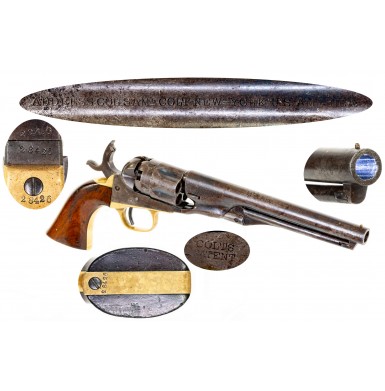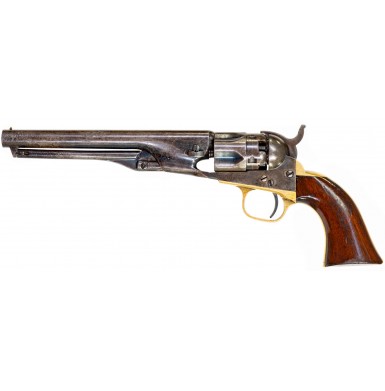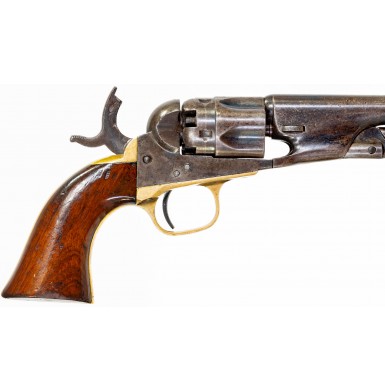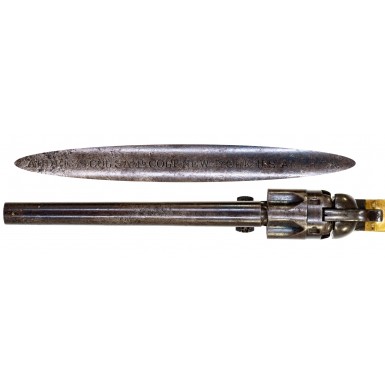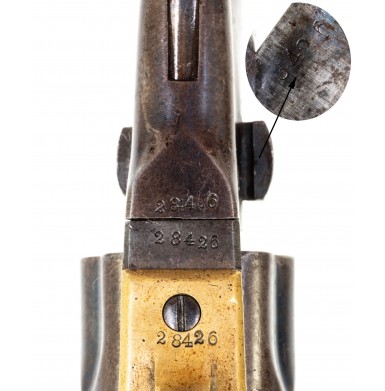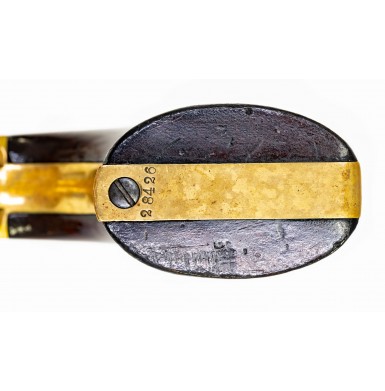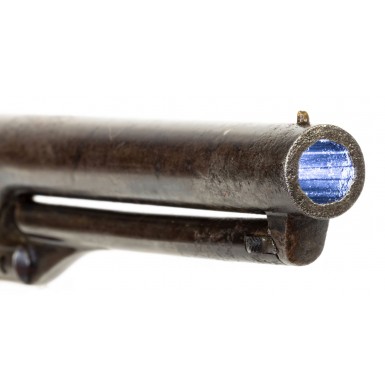Colt Model 1862 Police Revolver with a 6.5-Inch Barrel - About Fine
- Product Code: FHG-B182-SOLD
- Availability: Out Of Stock
-
$2,750.00
In 1861 Colt introduced two new pocket model revolvers in their more powerful .36 caliber chambering. Until that time, all of Colt’s “Pocket” guns had been .31 caliber, or in the case of some of the Root revolver production, .28 caliber. These new pocket revolvers can be considered “scaled up” 1849 Pocket Models or scaled down Belt Pistols (aka “Navy” models), as the guns had features of both their smaller and larger siblings. The two new models were known as the Model 1862 Police and the Model 1862 Pocket Revolver of Navy Caliber. The “Police” model resembled a scaled down, early production Colt Model 1861 New Model Belt (Navy) revolver, built on a Colt Model 1849 Pocket frame. The .36 caliber revolver had a five shot fluted cylinder and the grip frame and triggerguard were of Colt Pocket size and style. It had a round barrel, a creeping loading lever and was available in 3 ½”, 4 ½”, 5 ½” and 6 ½” barrel lengths. The Pocket Navy was essentially a scaled down Model 1851 Navy built on a Model 1849 Pocket frame, with a .36 caliber, 5 shot, rebated round cylinder that was roll engraved with the same Stagecoach Hold Up scene used on the Model 1849 Pocket. Like the Police model, it used a pocket-sized frame and triggerguard, but had an octagonal barrel and conventional swinging link loading lever like those used on the Model 1849 and Model 1851 revolvers. Like the Police, it was available in four different barrel lengths ranging from 3 ½” to 6 ½”, in 1” increments. The standard finish for both revolvers was blued barrels and cylinders, color casehardened frames and silver-plated brass backstraps, gripstraps and triggerguards. A few of the early production “Police” revolvers were produced with iron grip frames and triggerguards, which were silver plated as well, but these are only found on very low number, early production revolvers. Early production revolvers will be found with the desirable Hartford barrel address, but the majority of the production carried the typical one-line New York barrel address. Although both models are referred to with the model date of 1862, both went into production in 1861, and would remain in production until the end of the Colt percussion era in 1873. During that time some 47,000 of both models would be produced, manufactured concurrently, and utilizing the same serial number series, regardless of model. According to Colt researcher and author R.L Wilson, it is believed that about 60% of the total production of the two models was of the 1862 Police pattern, which would be approximately 28,200 guns, produced over about the 13-year production period. Compared to the Colt Pocket, with about 331,000 produced, this makes the 1862 Police a much less common gun, with only one being manufactured for about every eleven Model 1849 Pocket Models.
The Colt Model 1862 Police Revolver offered here is in about FINE condition. The revolver is one of the very desirable guns that was produced with the longest barrel length of 6 ½”. It has the typical fluted cylinder of the 1862 Police model and is serial numbered 28426, placing its production in early 1864. The top of the barrel is marked with the standard single line single line New York address that reads:
ADDRESS SAML COLT NEW-YORK U.S. AMERICA
The lower left side of the frame, forward of the cylinder is marked in two lines:
COLTS
PATENT
The left rear web of the triggerguard is marked 36 CAL to avoid any confusion that might arise and make the user think it was a .31 caliber pocket revolver. As the gun is a later production example there is no patent date marking in any of the cylinder flutes, nor is there a visible cylinder serial number, as it is stamped on the rear face of the cylinder. The matching serial number 28426 appears throughout the revolver and is present on the bottom of the barrel lug, frame, triggerguard and butt. The partial serial number 8426 appears on the arbor pin, on the rear face of the cylinder (which is partially obscured due to flash pitting), on the wedge and inside the backstrap cut out of the grip. The revolver retains some of its original blued finish, probably about 25% over all or possibly slightly more. The strongest areas of bright blue are found in protected areas. These include under the barrel where the loading lever has protected the finish and in the cylinder flutes. The frame shows nice traces of mottled casehardened coloring, again mostly in protected areas. The gun has a moderately oxidized mottled plum brown and dark gray patina mixed with scattered flecks of surviving blue. The metal is mostly smooth with scattered freckled patches of surface roughness and some scattered areas of light to pitting here and there. The pitting is most prevalent around the muzzle, on the reverse of the barrel near the muzzle, in a couple of other thumb sized patches on the barrel, on the forward portion of the loading lever, on the face of the cylinder and on the rear face of the cylinder in the percussion cone recesses. The gun has a really lovely, untouched appearance and does not appear to have been cleaned in modern times. The bore of the revolver is in about VERY GOOD+ to FINE condition. It is mostly bright with some scattered oxidation and small areas of scattered pitting with crisp strong rifling along its length. The original truncated cone brass front sight is in place on the top of the barrel, near the muzzle. The creeping loading lever retains some strong traces of its case coloring on the web, with the balance of the lever having taken on a dark brown patina with some scattered areas of bluish mottling. The loading lever functions smoothly and correctly and locks securely into place under the barrel when not in use. All of the original cones remain in place and show some wear but remain fairly crisp and completely usable. The original safety pins on the rear face of the cylinder are all in place and are in very nice condition. The hammer retains some muted traces of its case coloring with much of the hammer having a richly oxidized plum patina. The brass grip frame and triggerguard retain no external evidence of having been silver plated, but some minute traces of silver are present on the edges of the grip frame under the grip. The exposed brass has a lightly oxidized rich golden patina. The revolver is in FINE condition mechanically and times and indexes as it should. The action remains relatively crisp and tight. The one-piece walnut grip is in about FINE condition and are free of any breaks, cracks, or repairs. The grip retains about 85%+ of its original varnish, which shows some thinning, wear, and loss. The most apparent wear and loss is along the sharp edges at the base of the grip, but even this wear is light. The grip does show some lightly scattered small dings, rubs and mars, but nothing indicative of abuse, just some carry, handling, and use. As noted above, the grip is serial numbered to the gun in period ink in the backstrap cut out.
Overall, this is very nice and quite desirable example of a long-barreled Colt Model 1862 Police revolver, produced in 1862. Although the gun shows some light wear and moderate finish loss with some scattered oxidation overall, it still remains crisp, with very nice grips and is mechanically functional. The 1862 Police is literally ten times less common than the 1849 Pocket and is a much more aesthetically pleasing revolver than the 1849 model it was partially derived from. Due to their overall production numbers, these guns do not appear on the market with the same frequency as the 1849 Pocket and 1851 Navy. This an extremely nice example of Civil War era .36 Colt Police that will be a good addition to your collection of Colt percussion revolvers or Civil War era handguns.
SOLD
Tags: Colt, Model, 1862, Police, Revolver, with, a, 6.5, Inch, Barrel, About, Fine

